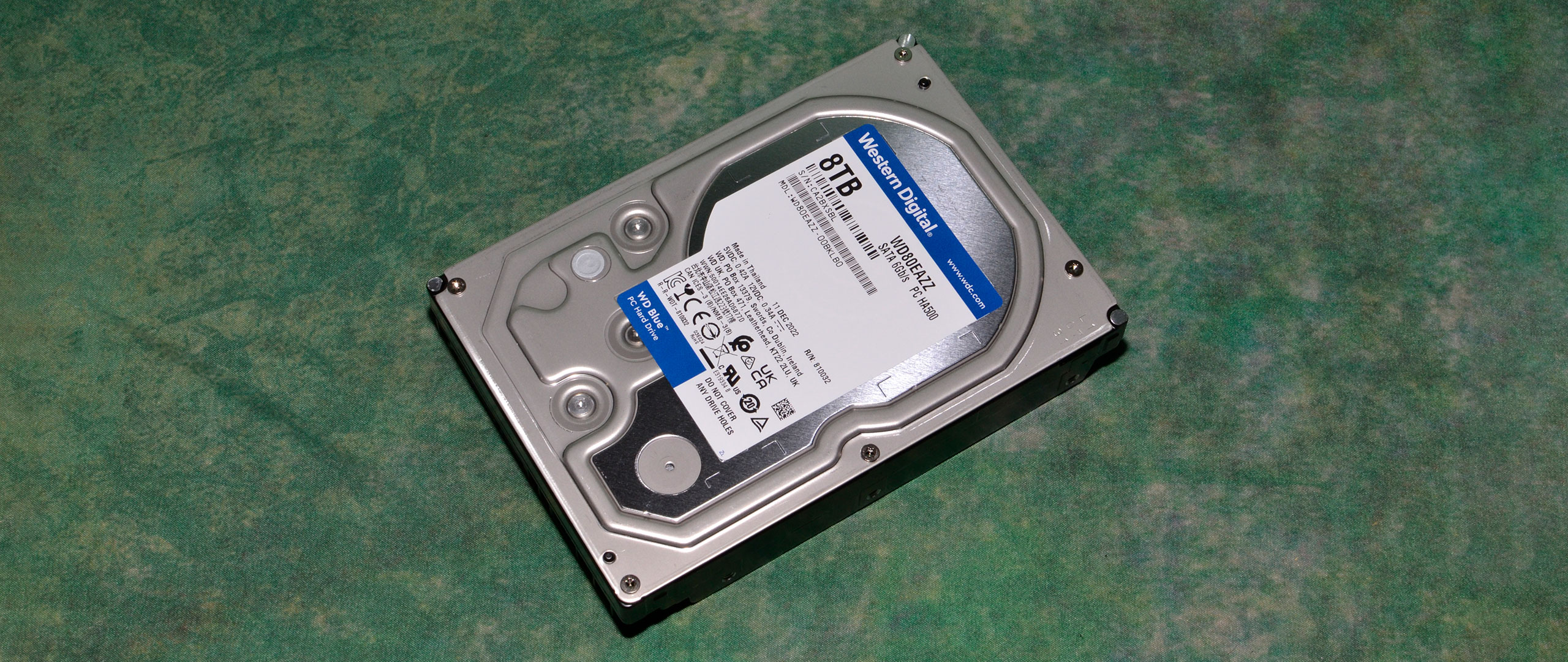Why you can trust Tom's Hardware
Comparison Products
The 8TB WD Blue HDD competes with other 8TB hard drives like the Seagate BarraCuda, the older HGST UltraStar He8, the Seagate IronWolf Pro 8TB, and the Seagate FireCuda. We also included larger 20TB drives in our test pool, like the WD Red Pro, the Seagate Exos X20, the Seagate IronWolf Pro, and the Seagate SkyHawk AI. The 14TB Seagate IronWolf Pro and 12TB WD Red Plus round out the list.
Trace Testing - 3DMark Storage Benchmark
Yes, gaming isn't the preferred use case for this class of hard drives, but we include these tests for perspective. Built for gamers, 3DMark’s Storage Benchmark focuses on real-world gaming performance. Each round in this benchmark stresses storage based on gaming activities, including loading games, saving progress, installing game files, and recording gameplay video streams.
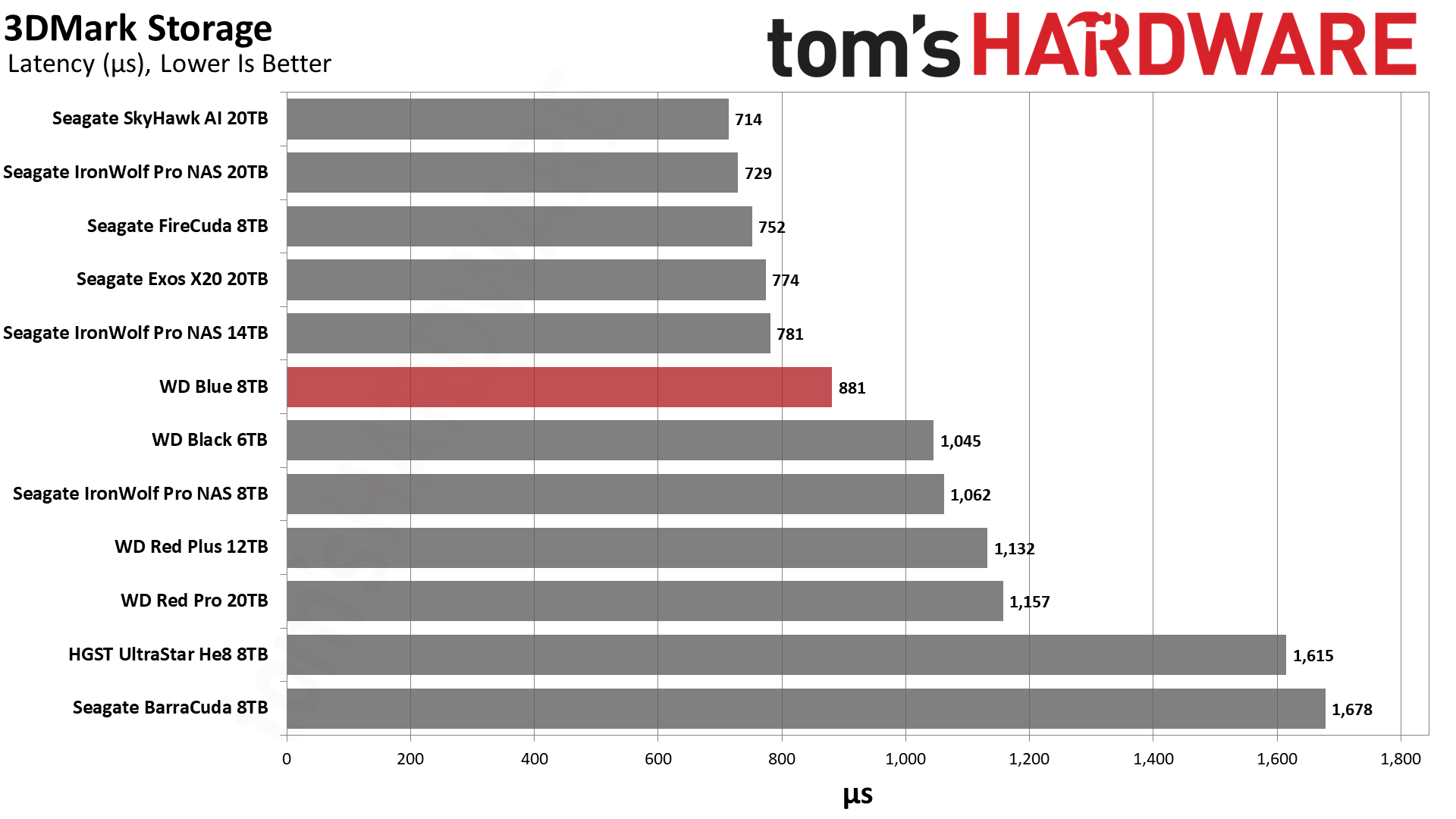
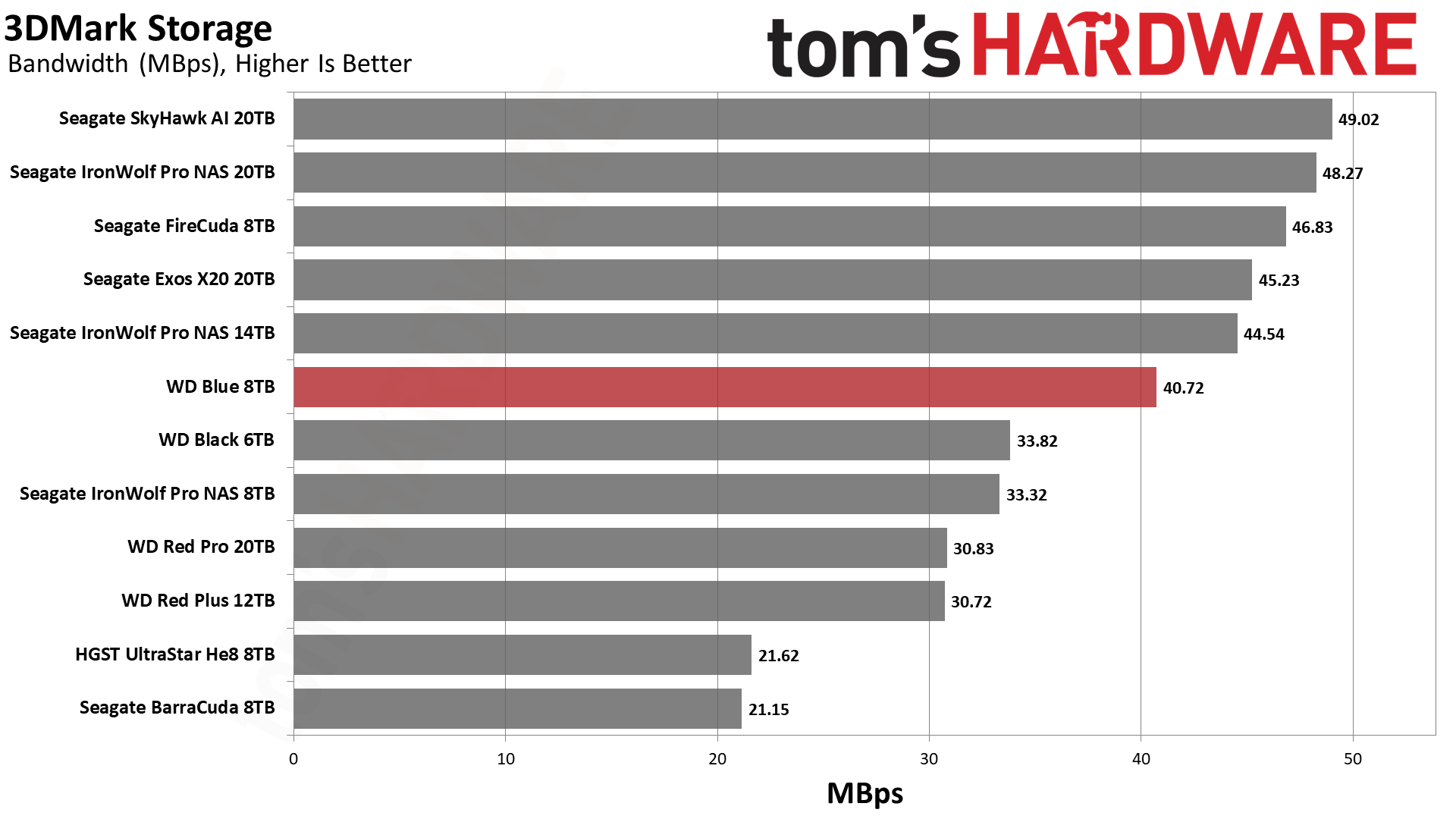
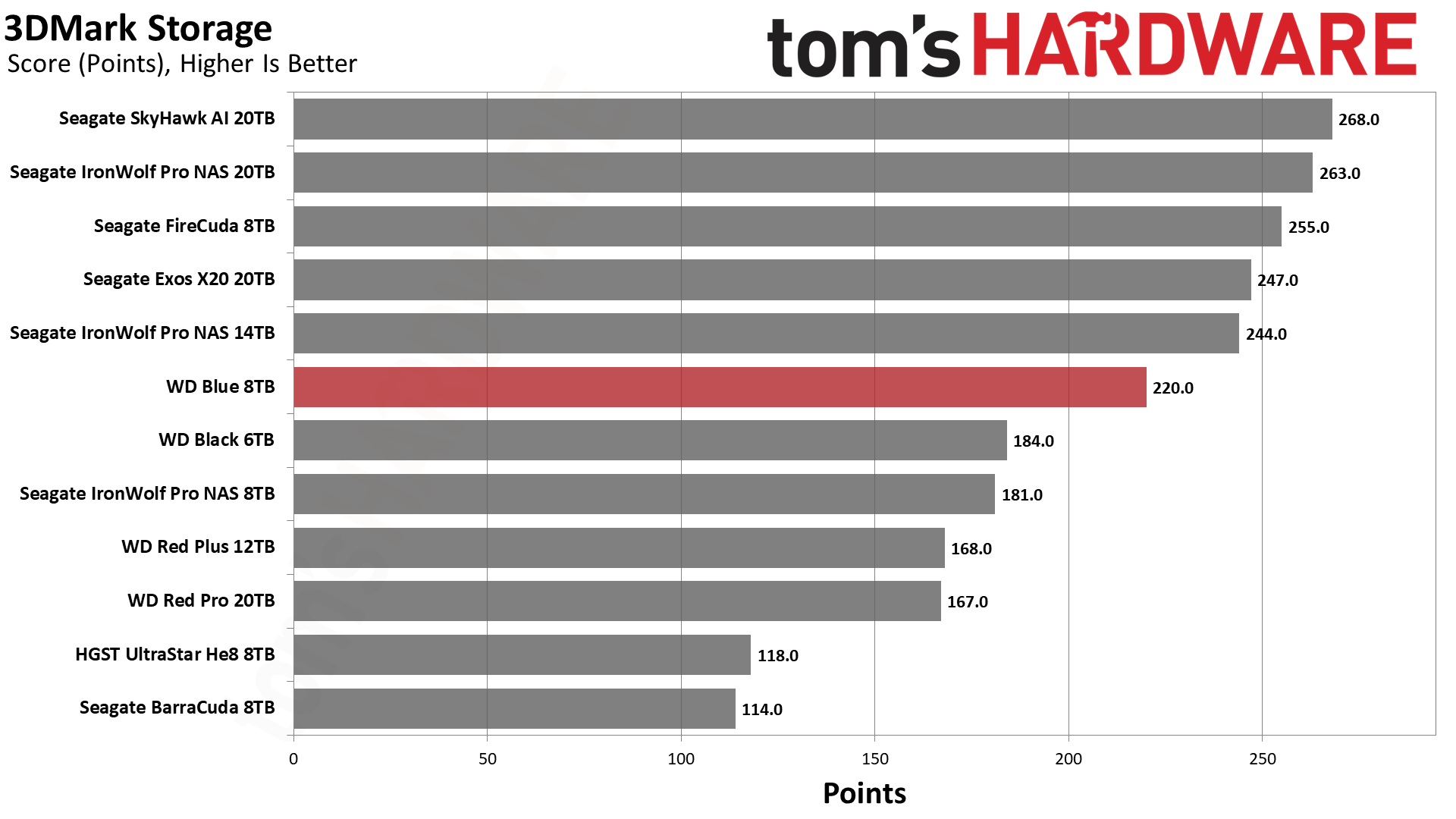
The WD Blue ends up in the middle of the pack in 3DMark. As expected, it handily beats the SMR-equipped 5400-RPM BarraCuda but falls shy of the 7200-RPM FireCuda.
Trace Testing – PCMark 10 Storage Benchmark
PCMark 10 is a trace-based benchmark that uses a wide-ranging set of real-world traces from popular applications and everyday tasks to measure the performance of storage devices.



The Blue is again in the middle of the pack with PCMark 10, but its performance isn't bad, given its spindle speed and pricing.
Transfer Rates – DiskBench
We use the DiskBench storage benchmarking tool to test file transfer performance with a custom 50GB dataset. We copy 31,227 files of various types, such as pictures, PDFs, and videos, to a new folder and then follow up with a reading test of a newly-written 6.5GB zip file.

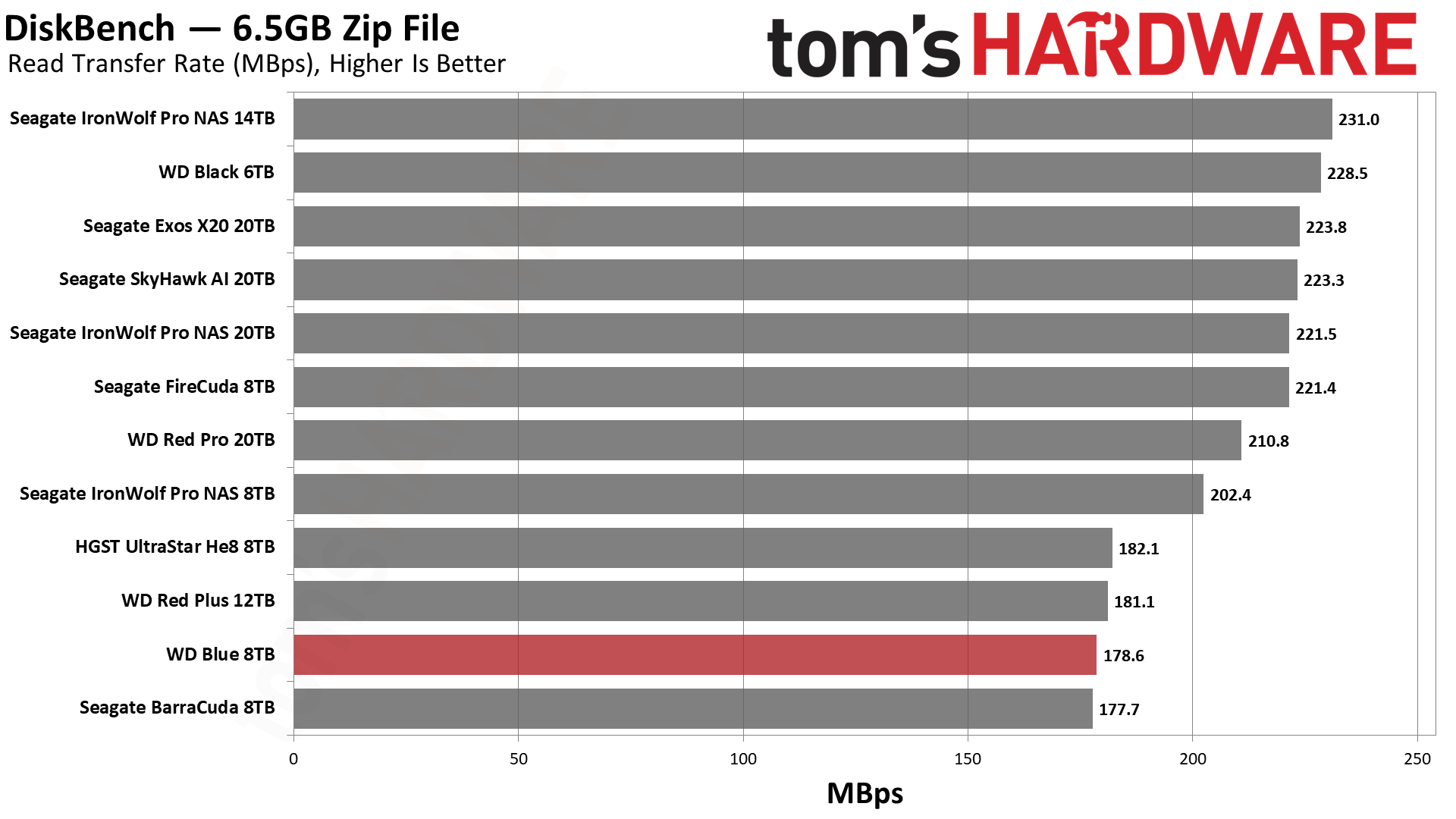
Here the Blue's 5640-RPM spindle speed hinders its performance as it falls behind all of the 7200-RPM drives and the larger Red Plus. It still manages to beat the SMR-equipped BarraCuda and older UltraStar HE8, though.
As expected with this class of drive, the Blue's copy speed is fairly unimpressive. You should factor this in when selecting a drive to purchase — a more expensive 7200-RPM model is a better fit if you're looking for faster file transfer performance.
Get Tom's Hardware's best news and in-depth reviews, straight to your inbox.
Synthetic Testing - ATTO / CrystalDiskMark
ATTO and CrystalDiskMark (CDM) are free and easy-to-use storage benchmarking tools that storage vendors commonly use to assign performance specifications to their products. Both of these tools give us insight into how each device handles different file sizes.
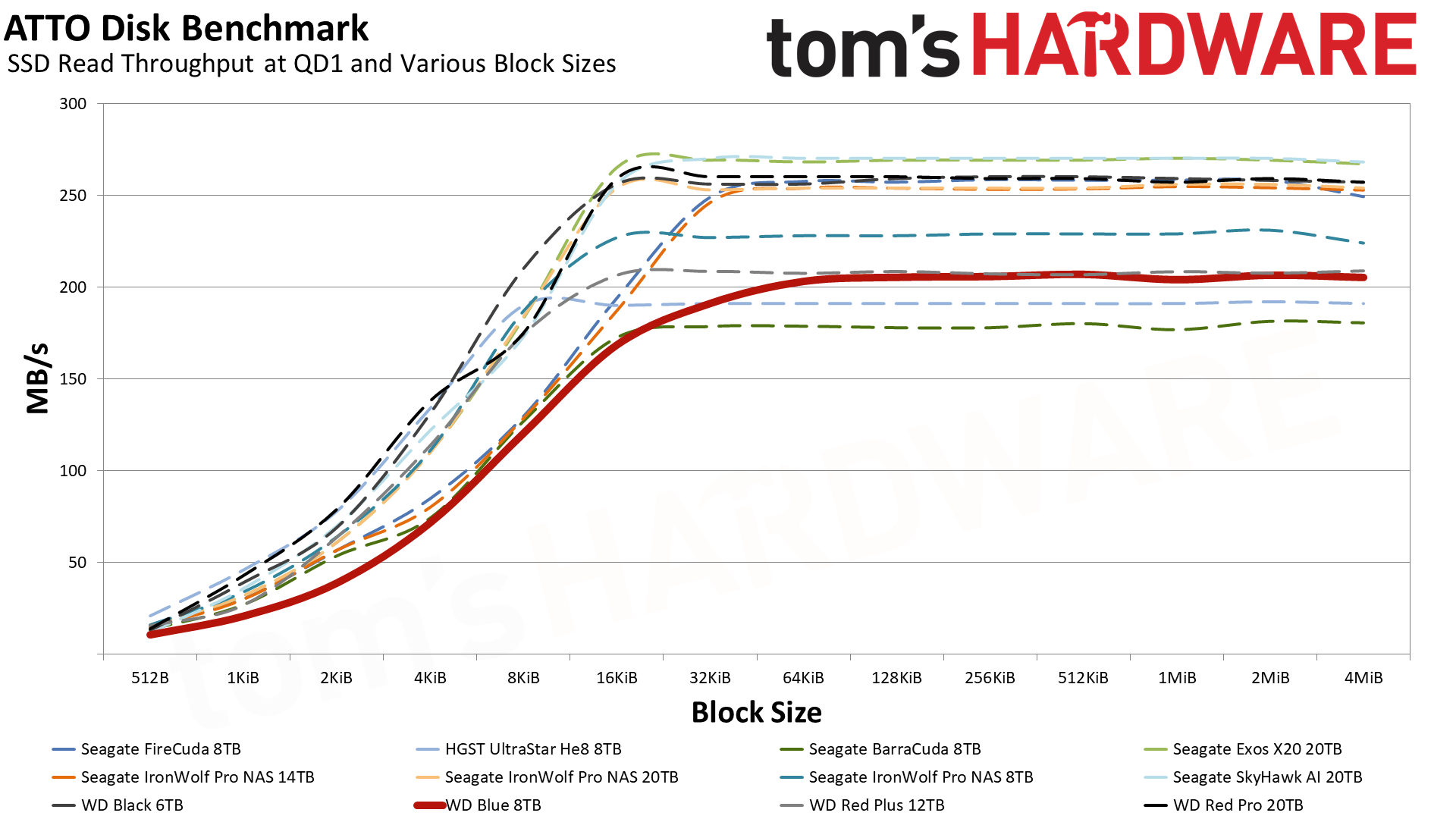


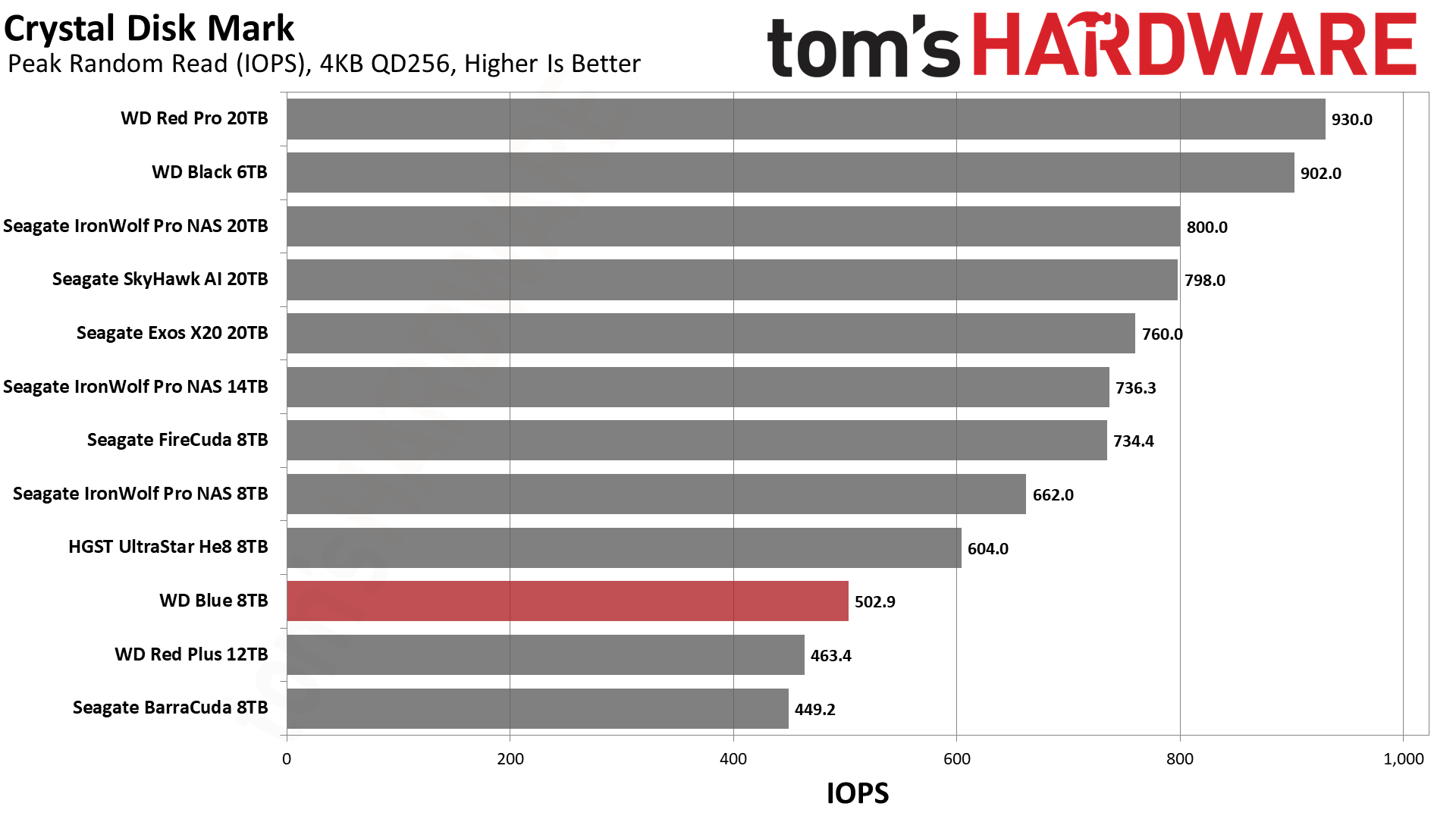

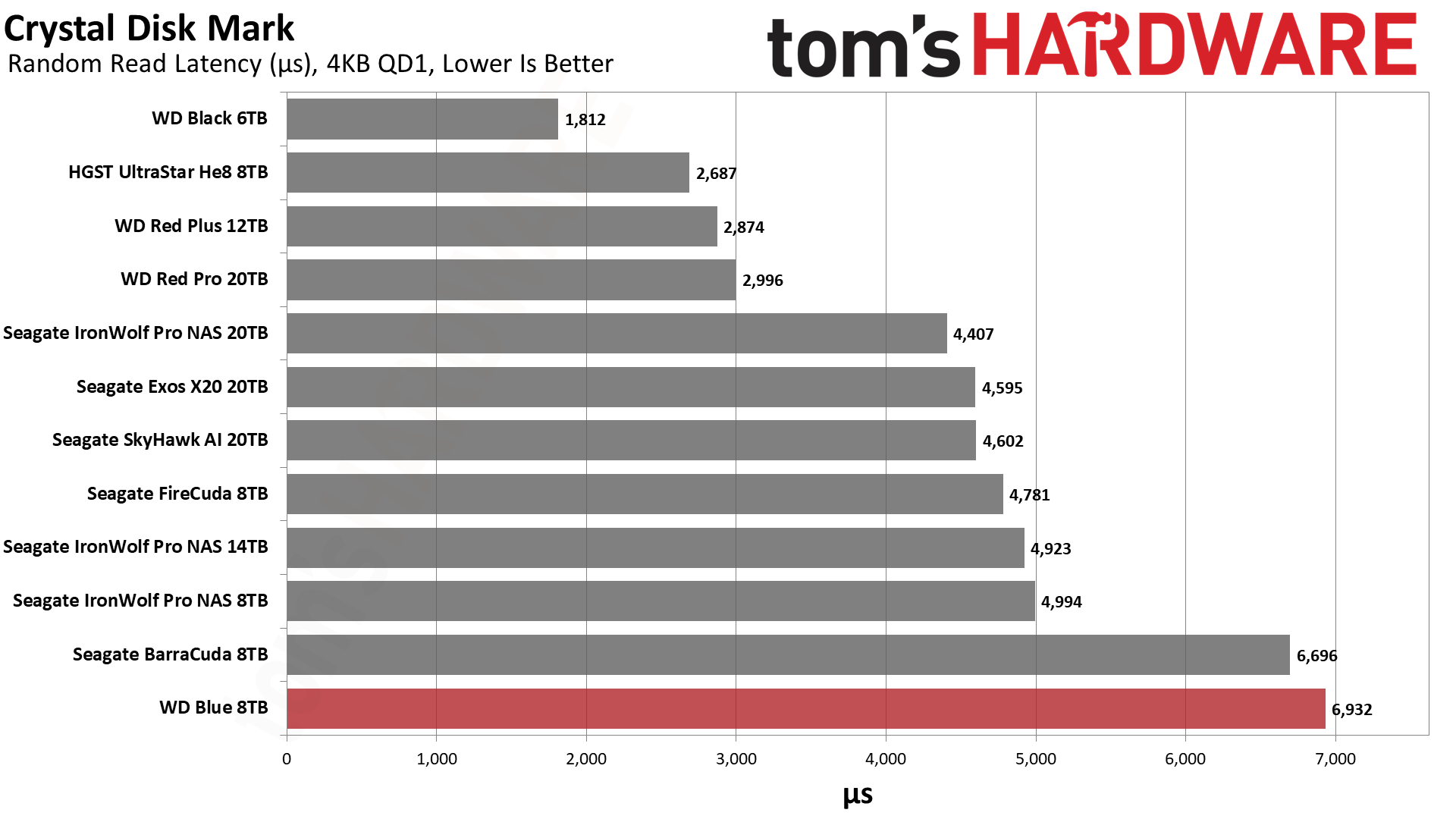

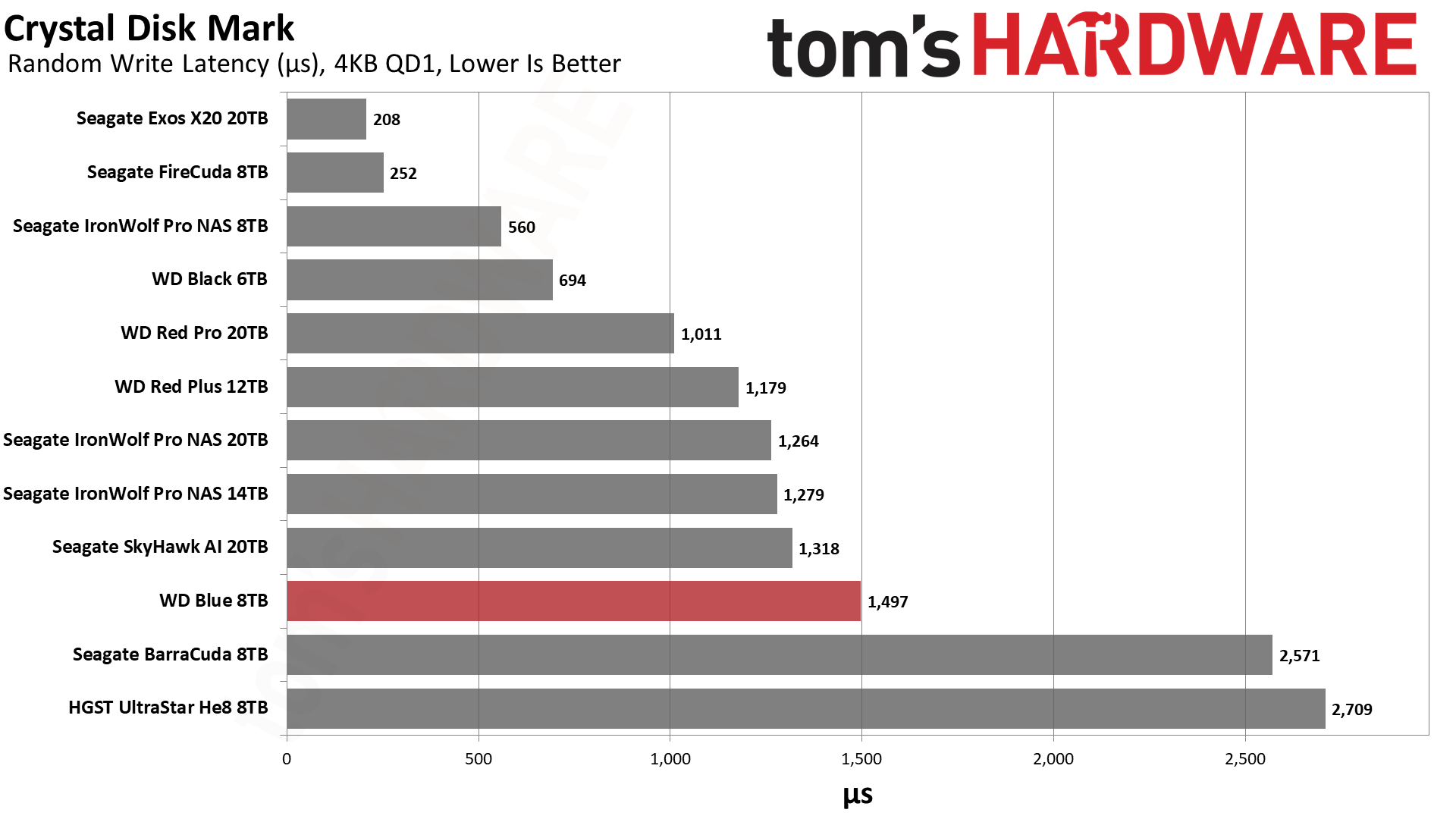


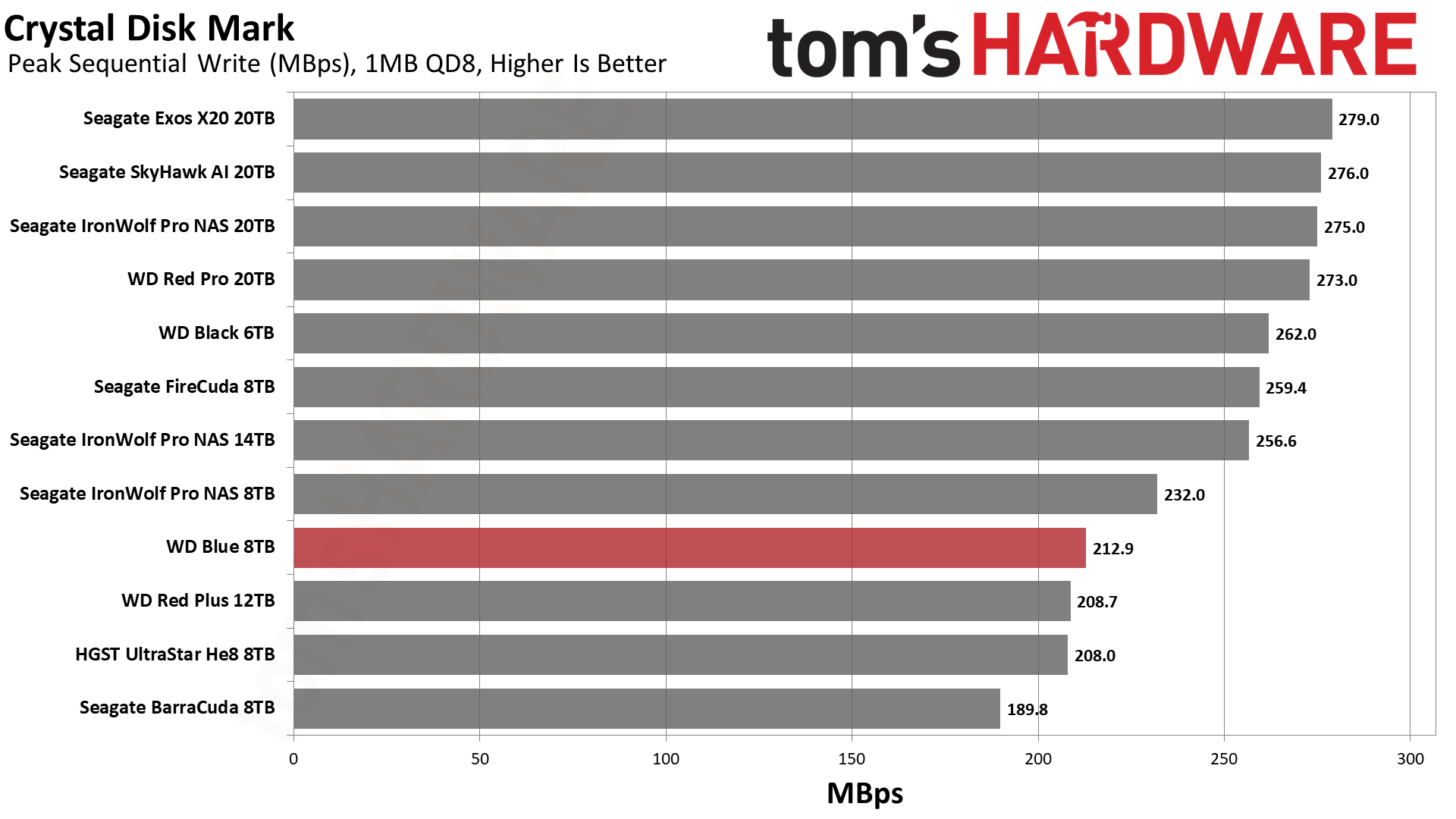

The Blue has a weak showing in ATTO, but this is expected, given its slower spindle speed. Sequential speeds are also lower in Crystal Disk Mark but high enough for a hard drive’s intended use. Random performance and latencies are also impacted by RPM, and here the Blue does poorly.
It's important to remember that this class of drive is tuned for the larger file sizes typically found in archival, backup, and bulk data storage applications. The WD Blue performs well in those types of tests, showing its advantage over the competing Seagate BarraCuda. The disadvantage of SMR tech is also clearly evident in the second image in the above album, where the SMR-equipped BarraCuda's write speed suffers tremendously at all block sizes.
Sustained Write Performance
Official write specifications are only part of the performance picture. Most HDDs implement a write cache which is a fast area of volatile memory such as DRAM. Sustained write speeds directly hit the platters and tend to be consistent. There are exceptions to both of these statements, as there are SSHDs (flash-containing hybrid HDDs), OptiNAND drives, and SMR drives that deviate from the traditional configuration. We use Iometer to detect the maximum sustained write speed of the HDD.

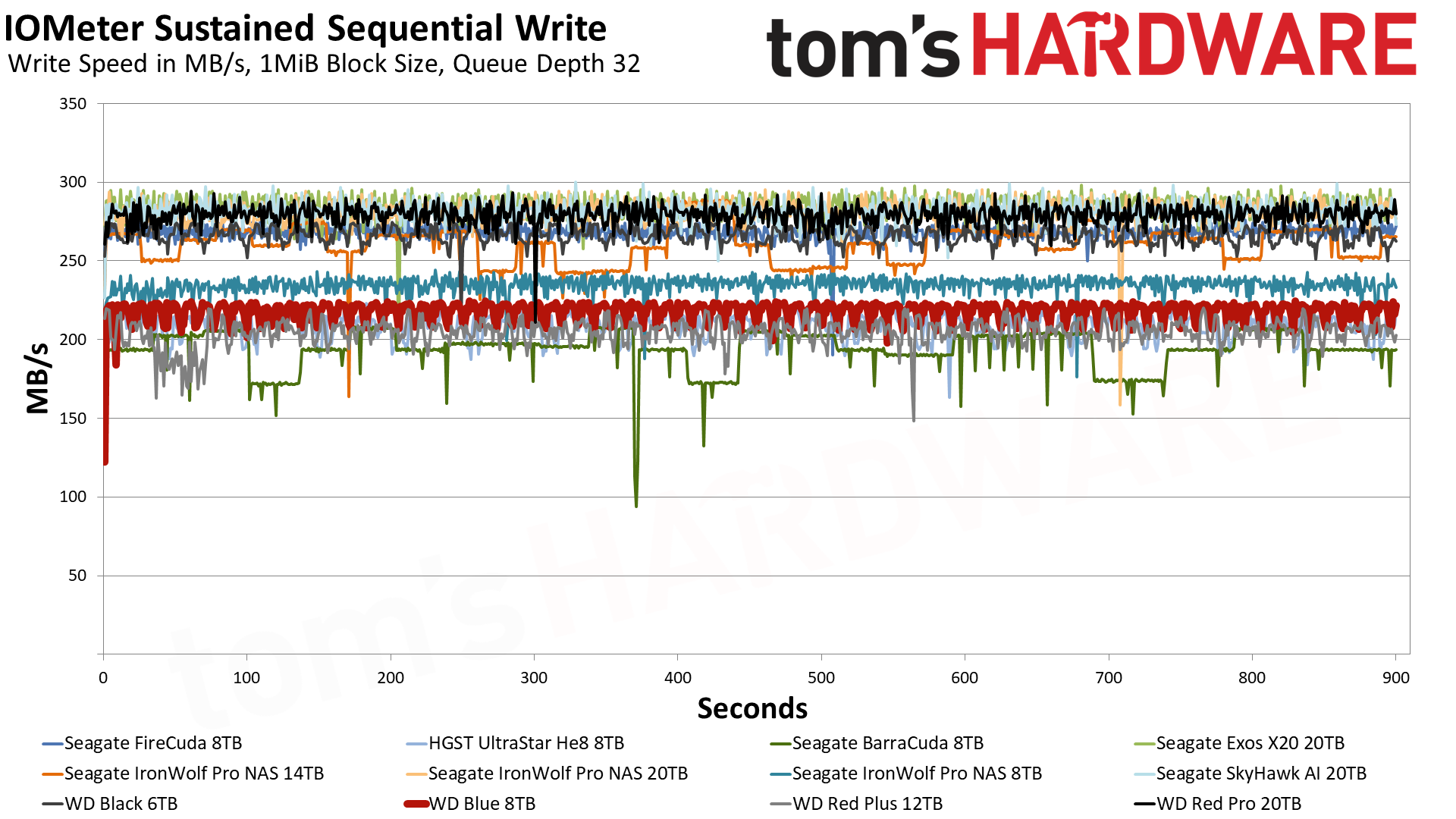
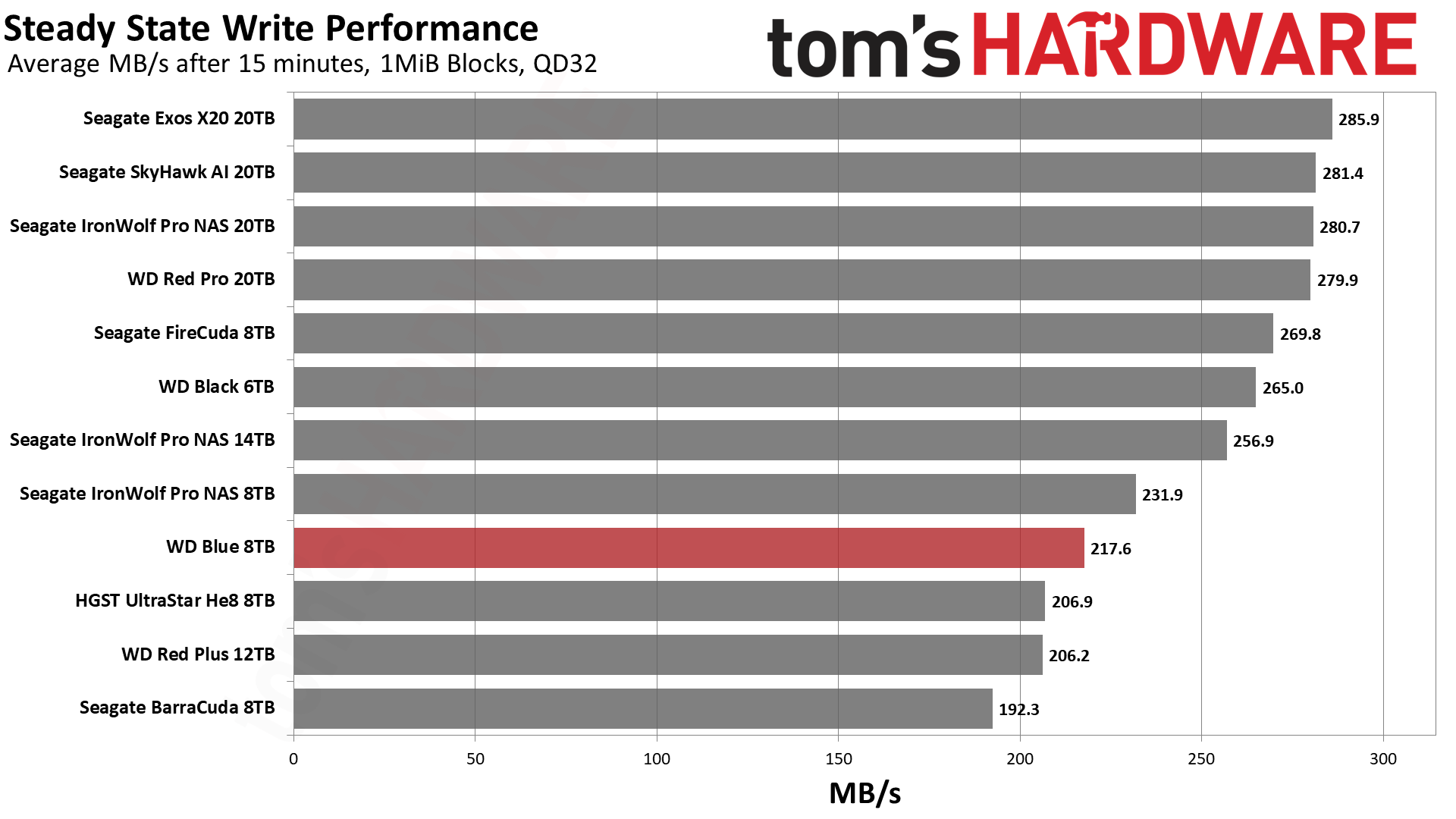
The Blue’s write performance is as expected and good enough for use as media storage, backup, archival use, etc. It is also sufficiently fast to store game streams and the like. Its write speed is more consistent than the SMR Seagate BarraCuda, and there’s no reason to pick the BarraCude over the Blue if you want a well-rounded HDD.
Power Consumption
We use the Quarch HD Programmable Power Module to gain a deeper understanding of power characteristics. Some drives can consume watts of power at idle while better-suited ones sip just milliwatts. Average workload power consumption and max consumption are two other aspects of power consumption, but performance-per-watt is more important. A drive might consume more power during any given workload, but accomplishing a task faster allows the drive to drop into an idle state more quickly, ultimately saving energy.
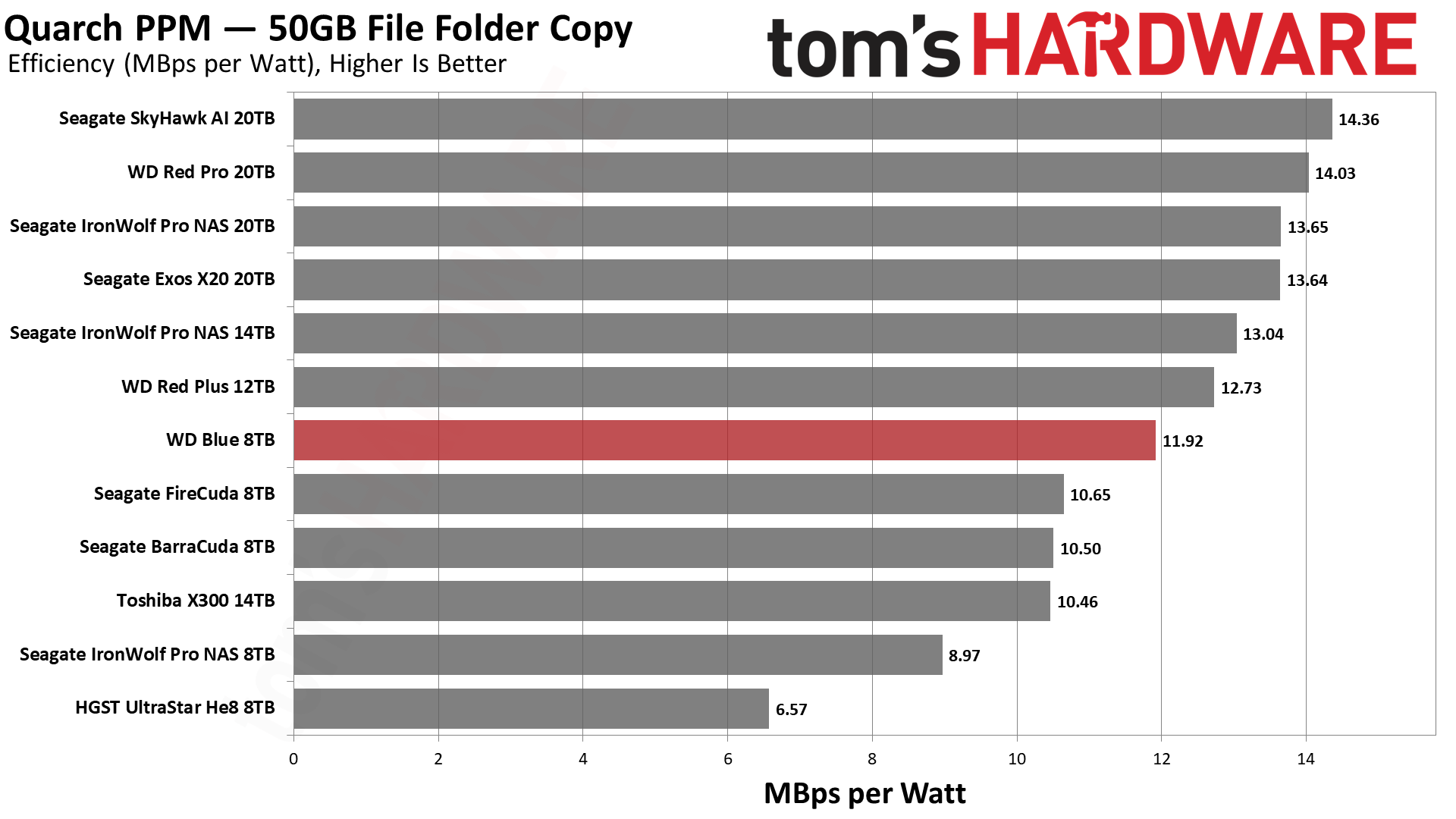

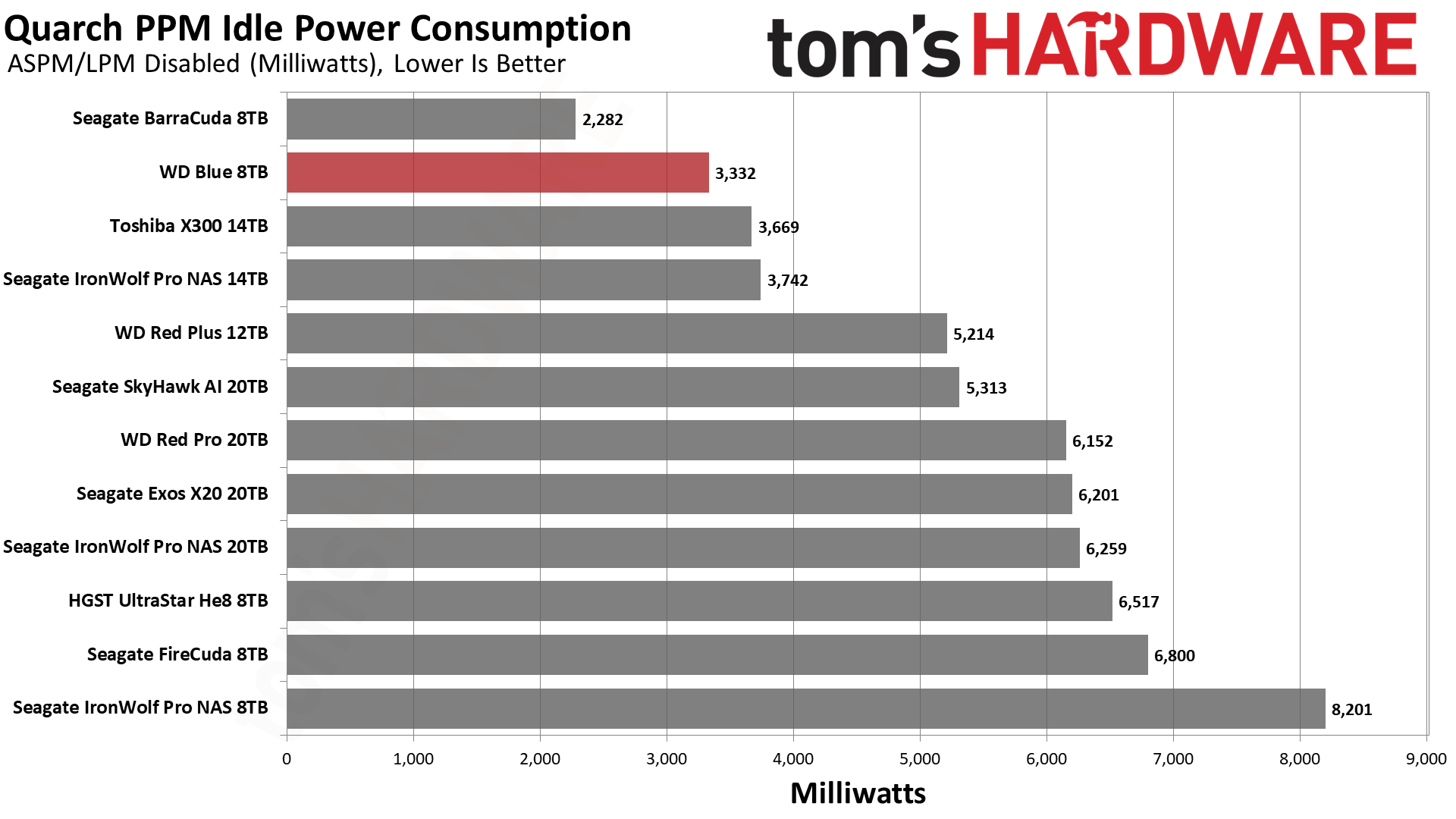

The Blue has low peak and average power consumption with moderate efficiency. Its 5640-RPM spindle speed reduces its performance for this workload, but its results are still reasonable. You'll notice the BarraCuda has a lower average power consumption during the operation, but its reduced performance results in less efficiency. Conversely, the BarraCuda has a significantly lower idle power draw, which is typically more important for backup and archival use cases.
Test Bench and Testing Notes
| CPU | Intel Core i9-12900K |
| Motherboard | Asus ROG Maximus Z790 Hero |
| Memory | 2x16GB G.Skill DDR5-5600 CL28 |
| Graphics | Intel Iris Xe UHD Graphics 770 |
| CPU Cooling | Enermax Aquafusion 240 |
| Case | Cooler Master TD500 Mesh V2 |
| Power Supply | Cooler Master V850 i Gold |
| OS Storage | Sabrent Rocket 4 Plus 2TB |
| Operating System | Windows 11 Pro |
Conclusion
Hard drive fanatics will instantly recognize the WD Blue lineup as the best way to get affordable “good enough” storage. WD Blue HDDs drop down to a lower RPM, which can be good from a heat and noise perspective, but the slower spindle speed also results in lower performance. The Blue drives also have a smaller DRAM cache and a less expansive warranty than the bolder, high-performance Black line.
WD has also snuck SMR technology, which has significant drawbacks, into the budget series drives like the Blue, but the company also offers CMR SKUs, including this 8TB model. In contrast, Seagate’s entire BarraCuda lineup uses the less-performant SMR tech. This gives the 8TB Blue an edge if you’re looking for a simple HDD to add more storage capacity, especially considering its lower pricing.
If you’re looking for more performance, we recommend the 7200-RPM Seagate FireCuda instead. It has a better warranty, providing extra peace of mind. If you need more capacity than the Blue and FireCuda lines offer — they top out at 8TB — you need to step up to NAS or enterprise drives, or more likely, the Toshiba X300 and X300 Pro series of drives made for high-end desktops and workstations. Most NAS drives are also positioned to serve as high-capacity HDDs for performance-focused desktop PCs, but conversely, you can save some money and run with the Blue if the drive will only see light use.
In fact, that’s exactly where the Blue shines, as it offers CMR technology at a good price. A longer warranty would be nice, and Seagate’s data recovery service with the FireCuda makes the jump up to a higher tier worthwhile for some. On the other hand, no data should be stored without a backup, so the value of the data recovery service might hinge on how robust your data backup plan is.
The Blue’s performance is as expected from a 5400-RPM-class HDD, which is to say lackluster, but it is far better than SMR drives; the Blue's standard CMR technology gives you more flexibility in how you can use the drive. Overall, the 8TB WD Blue is a basic, entry-level HDD that fits its niche well.
MORE: Best SSDs
MORE: Best External SSDs and Hard Drives
MORE: How We Test HDDs And SSDs
MORE: All SSD Content

Shane Downing is a Freelance Reviewer for Tom’s Hardware US, covering consumer storage hardware.
-
YouFilthyHippo I'm amazed hard drives still exist, with how fast SSD prices are falling. For 99.999999999999% of consumers, there is no incentive to choose a hard drive over an SSD. I guess... for mass-storage: backups of large files, I guess they can be useful for that. But other than that, I dont see the pointReply -
rluker5 I have one of these. Picked it up a year ago when SSDs cost about twice what they do now, and my 3TB Barracuda was failing. Certainly faster than any of my older HDDs were. Also much slower than an SSD.Reply
But it is fast enough for it's purpose as an infrequently accessed backup stuff drive. Phone pictures, music, movies, captures, OS backups, whatever. It's fast enough to be convenient and big enough to be careless with what you save on it. It won't last as long as an M-disc, but is so much faster. I only put very important stuff on M-discs because it takes so long.
Not the greatest, but reliable, cheap for the space, and fast enough for media and storage. Still plays most games ok, but I certainly wouldn't use it for an OS drive. -
Thunder64 I got one as a backup drive not too long ago. I've had better luck with WD but couldn't justify double the price for a Gold variant this time around. Now I have my WD 4TB Gold as a backup and this 8TB serves as another backup, as well as other mass storage needs.Reply
I certainly would not get it if speed is what matters. Also, I was a bit surprised that two year warranties are the new normal. I thought it used to be three years, with five for Black and Gold drives? I have a 1TB drive that's been running for over 10 years. I certainly don't trust it, neither does SMART, but it still works. I doubt these new drives will last that long. -
bit_user Reply
This product line is particularly endangered, since it's not a NAS or server-oriented model, nor is it too much bigger than the size of SATA SSDs currently on the market.YouFilthyHippo said:I'm amazed hard drives still exist, with how fast SSD prices are falling.
Sure, there is. Backups - not just of large files, but any files you might want to recover a long time hence. Try the following:YouFilthyHippo said:For 99.999999999999% of consumers, there is no incentive to choose a hard drive over an SSD. I guess... for mass-storage: backups of large files,
Copy some files onto a SSD and a hard disk.
Disconnect them and place them in a drawer or on a shelf.
Wait 5 years.
Reconnect them and see which one is still readable.
If you're using a modern SSD (TLC or QLC), I'll bet you it's not going to be the SSD.
I accidentally conducted this experiment at work, when I connected a TLC SSD from a PC that had been unplugged for several years. The parts of the drive that hadn't been written since it was manufactured produced errors, when I tried to read them (I did the equivalent of a "surface scan"), and it was manufactured less than 5 years prior. -
YouFilthyHippo Replybit_user said:This particular product line is particularly endangered, since it's not a NAS or server-oriented model, nor is it too much bigger than the size of SATA SSDs currently on the market.
Sure, there is. Backups - not just of large files, but any files you might want to recover a long time hence. Try the following:
Copy some files onto a SSD and a hard disk.
Disconnect them and place them in a drawer or on a shelf.
Wait 5 years.
Reconnect them and see which one is still readable.
If you're using a modern SSD (TLC or QLC), I'll bet you it's not going to be the SSD.
I accidentally conducted this experiment at work, when I connected a TLC SSD from a PC that had been unplugged for several years. The parts of the drive that hadn't been written since it was manufactured produced errors, when I tried to read them (I did the equivalent of a "surface scan"), and it was manufactured less than 5 years prior.
Its a known fact that HDD are far more reliable than SSDs. So there is that. I think that we are at a point where the only logical use case for hard drives are mass-storage or long term backup, or disk images. Hold all your music, movies, documents, photos, that sort of stuff. That stuff wont be bottlenecked by HDD speeds. I have a 14TB HDD myself. Its just a data storage piece. All it does is store data for access at any time. Just media and stuff. But I wouldn't dare run games, an OS, big applications on it -
kyzarvs Reply
All that data has to go somewhere. My Steam folder is 3TB+ then there's GoG, Epic etc etc. I access it from multiple machines, so makes sense to have it in one place. It's only a couple of games recently that utilise directstorage (Diablo IV and Forspoken - neither of which I'm overly interested in) where SSDs make any appreciable difference - I did a bunch of tests with GTA-V on local spinner, networked NAS and local nvme a while ago - there was like 10s of initial loading time between them and zero difference once in-game.YouFilthyHippo said:I'm amazed hard drives still exist, with how fast SSD prices are falling. For 99.999999999999% of consumers, there is no incentive to choose a hard drive over an SSD. I guess... for mass-storage: backups of large files, I guess they can be useful for that. But other than that, I dont see the point
Add to that my work data, media storage (we run Nextcloud for all automatic media storage from mobile devices) - yeah, it's pretty easy in a busy family with a lot of data needs (my daughter is 22 and has her own gaming storage requirements for example) to justify a FreeNAS box with a decent 5-drive RAID of 'spinners. I think we have just over half of our 23TB available in use. At $100 roughly for 8TB, the cost is still a significant factor and a RAID can still saturate almost any network connection at home, so no point in spending more on something with potentially a lower MTBF and performance you can't access. I freely admit that as I own an IT company, I'm not in the normal percentage of users, but there is still more than a valid case for spinners as soon as longevity and networks are involved.
Obviously for boot drives nvme is fantastic and Windows has bloated to the point where it's not really viable on a spinner any more and I wouldn't have them in any box I am in earshot of. Still not as fast to boot as XP was back in the day on a 2x WD Raptor 10k rpm striped array, but such is the price of progress! -
newtechldtech Replybit_user said:This product line is particularly endangered, since it's not a NAS or server-oriented model, nor is it too much bigger than the size of SATA SSDs currently on the market.
Sure, there is. Backups - not just of large files, but any files you might want to recover a long time hence. Try the following:
Copy some files onto a SSD and a hard disk.
Disconnect them and place them in a drawer or on a shelf.
Wait 5 years.
Reconnect them and see which one is still readable.
If you're using a modern SSD (TLC or QLC), I'll bet you it's not going to be the SSD.
I accidentally conducted this experiment at work, when I connected a TLC SSD from a PC that had been unplugged for several years. The parts of the drive that hadn't been written since it was manufactured produced errors, when I tried to read them (I did the equivalent of a "surface scan"), and it was manufactured less than 5 years prior.
Your experiment with your old SSD is flawed . because you dont know the reason behind the errors , could be environmental. it depends on the SSD as well , "cheap" ones can retain data unplugged for 2 years only , and "good ones" 5 years. some manufacturer even claim 15-20 years but for sure not the "consumer" grades.
NOW !! having said that !
it is time to make a kit for storing SSDs , connected to power all the time . preventing electron leakage from SSDs that corrupts DATA ..cheap and easy .. -
YouFilthyHippo Reply
Thats another thing I can't get my head around, is why SSDs make loading times only 2x faster than a spinner even though they are 15x faster or more. I think I need an ELI5 on this one. Anything?kyzarvs said:All that data has to go somewhere. My Steam folder is 3TB+ then there's GoG, Epic etc etc. I access it from multiple machines, so makes sense to have it in one place. It's only a couple of games recently that utilise directstorage (Diablo IV and Forspoken - neither of which I'm overly interested in) where SSDs make any appreciable difference - I did a bunch of tests with GTA-V on local spinner, networked NAS and local nvme a while ago - there was like 10s of initial loading time between them and zero difference once in-game.
Add to that my work data, media storage (we run Nextcloud for all automatic media storage from mobile devices) - yeah, it's pretty easy in a busy family with a lot of data needs (my daughter is 22 and has her own gaming storage requirements for example) to justify a FreeNAS box with a decent 5-drive RAID of 'spinners. I think we have just over half of our 23TB available in use. At $100 roughly for 8TB, the cost is still a significant factor and a RAID can still saturate almost any network connection at home, so no point in spending more on something with potentially a lower MTBF and performance you can't access. I freely admit that as I own an IT company, I'm not in the normal percentage of users, but there is still more than a valid case for spinners as soon as longevity and networks are involved.
Obviously for boot drives nvme is fantastic and Windows has bloated to the point where it's not really viable on a spinner any more and I wouldn't have them in any box I am in earshot of. Still not as fast to boot as XP was back in the day on a 2x WD Raptor 10k rpm striped array, but such is the price of progress! -
bit_user Reply
Huh? This was stored in a normal office environment. No extreme temperatures or anything like that. Exactly the kind of conditions where you'd normally have your data at rest.newtechldtech said:Your experiment with your old SSD is flawed . because you dont know the reason behind the errors , could be environmental.
Source? I've looked into this, a fair amount. The only NAND which is going to retain data for anything remotely close to those periods of time are the slow, low-capacity chips used to embed firmware in devices, which is completely irrelevant to this discussion.newtechldtech said:it depends on the SSD as well , "cheap" ones can retain data unplugged for 2 years only , and "good ones" 5 years. some manufacturer even claim 15-20 years but for sure not the "consumer" grades.
Manufacturers tend not to be very forthcoming with offline data retention figures. If you have anything remotely recent, please share. Enterprise storage product tend to specify 90 days, only. However, that's a minimum requirement and does not reflect testing of what they actually achieve.
LOL, like a trickle charger for a car battery?newtechldtech said:NOW !! having said that !
it is time to make a kit for storing SSDs , connected to power all the time . preventing electron leakage from SSDs that corrupts DATA ..cheap and easy ..
🙄
A better option might be to keep them in the refrigerator or freezer, sealed in moisture-proof bags with desiccant.
